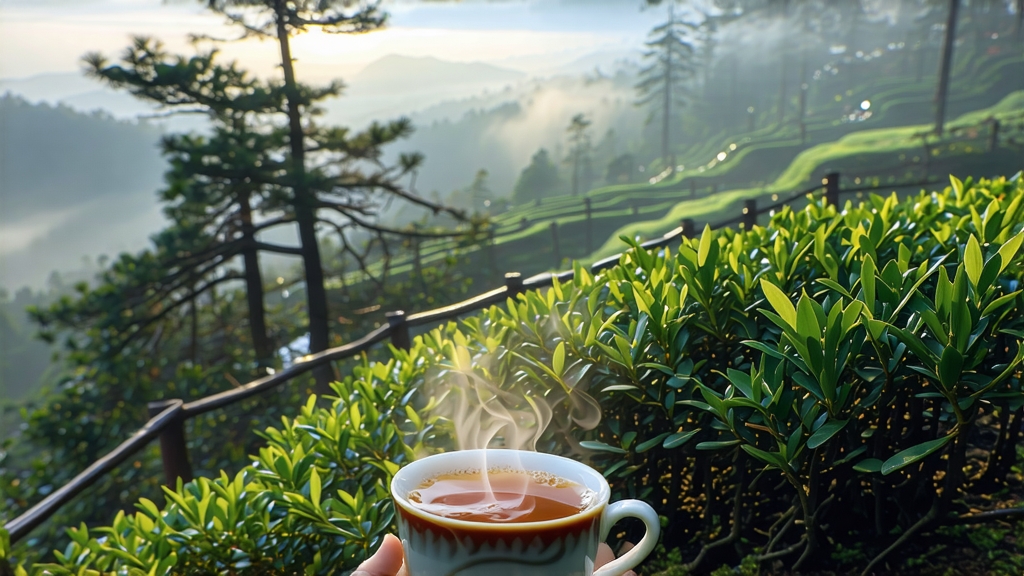
Alishan High-Mountain Oolong, known in Chinese markets as “Alishan Qing Xiang Oolong,” is one of Taiwan’s most celebrated gifts to the world of tea. Grown between 1,000 and 1,400 meters above sea level in the Alishan mountain range of Chiayi County, this tea belongs to the broader family of Formosa oolongs, yet it possesses a personality so distinct that seasoned drinkers can identify it blindfolded. Its story begins in the mid-19th century, when cultivars originally from China’s Fujian province—chiefly Qing Xin (also spelled Chin Hsin) and a few Jin Xuan plants—were carried across the Taiwan Strait by itinerant tea makers seeking cooler climates and unexplored terroirs. The indigenous Tsou people had long inhabited the cloud-forested slopes, but it was not until the construction of the Alishan Forest Railway in 1912 that tea seedlings could be transported in bulk up the switch-back tracks, past cedar and cypress, to clearings where morning mist and afternoon fog created a natural shade cloth.
The defining character of Alishan oolong is born at altitude. Cool nights slow leaf metabolism, thickening cell walls and concentrating amino acids, while strong ultraviolet radiation at noon prompts the bush to produce more aromatic volatiles as a sunscreen. The result is a leaf that looks almost emerald after roasting, infusing a liquor the color of pale chardonnay and releasing a bouquet that oscillates between white orchid, fresh cream, and a hint of alpine sugarcane.
Farmers usually pluck in spring (late March to early May) and again in winter (mid-October to late November), when the diurnal temperature swing can exceed 15 °C. Only the top two leaves and a bud are taken, ideally before 10 a.m. while dew still pearls the surface. Once picked, the leaves are spread on bamboo trays and left under the mountain sun for 20–40 minutes, a crucial step called “outdoor withering” that initiates enzymatic oxidation. The intensity of UV at altitude means timing must be exact; over-exposure can bake the leaf edges and flatten fragrance.
Next comes indoor withering and tossing, the heartbeat of oolong craft. The leaves are moved onto reed racks inside a drafty pavilion, where they rest for an hour, then are gently tumbled in a cylindrical bamboo drum for thirty seconds. This bruises the edges without breaking the spine, encouraging partial oxidation. The cycle—rest, toss, rest—is repeated 5–7 times through the afternoon and often past midnight. A master craftsman listens for a rustling sound like distant rain; when the leaf emits a subtle apple-skin note, oxidation has reached the desired 20–30 %, far less than the 60 % of traditional dong ding oolong.
Fixation follows: leaves are flash-heated in a rotating drum at 280 °C for three minutes, deactivating enzymes and locking in the green-floral spectrum. While still warm, they are wrapped in large square cloths and rolled under mechanical pressure into tight hemispheres. This ball-rolling phase, repeated dozens of times with brief unwrap-and-redden intervals, forces cell sap to the surface, where it will later crystallize into aroma. Finally, the pellets are dried at 90 °C until moisture drops below 5 %, then rested for 48 hours to let residual heat dissipate.
Most Alishan oolongs undergo a light bake, or “wen huo,” 70–80 °C for six hours, giving a clean, uplifting cup. A minority are given a deeper charcoal roast months later, creating “honey Alishan” with notes of toasted almond and caramel, but purists seeking the mountain’s voice prefer the greener style.
To brew, use a porcelain gaiwan of 120 ml and 5 g of leaf. Rinse with 95 °C water, discarding the first infusion to awaken the tightly curled pellets. Subsequent steeps begin at 30 seconds, adding five seconds each round. The liquor should shimmer like liquid jade; tilt the cup against white porcelain to observe the pale gold rim. Inhale deeply: top notes are orchid and lily, followed by a creaminess reminiscent of Taiwanese fresh milk, finishing on a cool menthol breeze that lingers in the throat—what locals call “yun,” a returning rhyme.
Flavor mapping can be done in three axes. Vertical: the high-p